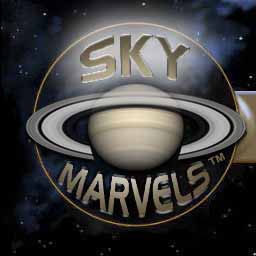








AVAILABLE MONTHS
2010:
Jan
Feb
Mar
Apr
May
Jun
Jul
Aug
Sep
Oct
Nov
Dec
2011:
Jan
Feb
Mar
Apr
May
Jun
WELCOME TO THE LAUNCH!
Welcome to the launch of this website! You are invited to return often to enjoy its many and growing offerings that will help you get the most out of CELESTIA.
Here you'll be treated to all of the information, insight and inspiration that you've always known were possible with CELESTIA. Plus, you'll revel in the "pure fun" of constant discovery!
If you have any suggestions on how to make this website better, please contact us.
EARTH AT PERIHELION: 2010 Jan 3
When is Earth at perihelion—the point of its orbit closest to the Sun? Contrary to popular belief, this happens in winter NOT summer! Versions 1.6.x and 1.4.1 of CELESTIA place Earth at perihelion on 2010 Jan 3, at 00:27:46 UTC and 00:26:40 UTC respectively.
CHRISTMAS STAR?
ASTRONOMY magazine this month looks at sky objects and events that could have produced the biblical "star in the east." One candidate is Venus's transit of Jupiter in the year -1 on Jan 17, when the two brightest objects in the sky (after the Sun and the Moon) did appear to "merge" for a brief time when viewed from some locations on Earth.
Here's how CELESTIA shows the event from deep in the Antarctic, which had the best view of the transit (shown in these views with Celestial North "up"): (1.6.x), (1.4.1).
THE SUN
APPARENT PATH OF THE SUN: 2010 Jan
Here are the Sun's positions along the Ecliptic at 00:00 UTC on the days shown.

The slightly curved lines above and below the Ecliptic show the extent of the Zodiac, which you may download from our Bonuses page and add to any version of CELESTIA. Note that the curve in the Zodiac lines is the result of CELESTIA's rendering in perspective.
 W A R N I N G ! It is never safe to look directly at the real Sun with the naked eye! Moreover, looking at it through a telescope or binoculars—even for an instant—can cause permanent blindness! NEVER DO IT! Consult the professionals at your local planetarium or observatory to learn how you can safely "observe" the Sun and any SOLAR eclipse!
W A R N I N G ! It is never safe to look directly at the real Sun with the naked eye! Moreover, looking at it through a telescope or binoculars—even for an instant—can cause permanent blindness! NEVER DO IT! Consult the professionals at your local planetarium or observatory to learn how you can safely "observe" the Sun and any SOLAR eclipse!
Of course, you can safely view CELESTIA's depiction of the Sun's apparent path in the sky. Here are the links: (1.6.x) (1.4.1). Note that versions 1.6.x and 1.4.1 differ in the way their "follow" and "lock" features work. If you "follow" Earth and then "lock" the Sun to it, versions 1.6.x and 1.4.1 respectively maintain the "attitudes" of the Ecliptic and the the Celestial Equator. This means that the Ecliptic remains "level" when you run the first link, but begins to tilt when you run the second! Differences like this will be discussed on our Help page.
HALF OF EARTH IN SUNLIGHT & DARKNESS
During your voyages in CELESTIA, would you like to be able to position yourself directly over the center of the half of Earth in sunlight or the half in darkness at any time this month? On our Tips page, you'll find that it's quite easy to do so! If you're any kind of sky watcher at all, you probably know just how helpful this can be!
THE MOON
PHASES OF THE MOON: 2010 Jan
In UTC per CELESTIA 1.6.x (& 1.4.1):
3rd Qtr: Jan 7, 10:40 (10:41). New: Jan 15, 7:12 (7:13).
1st Qtr: Jan 23, 10:54 (10:55). Full: Jan 30, 6:18 (6:19).

Produced with our "Moon Phase Calendar" script. The numbers of the days of the month were added with an image-editing program.
LUNAR PERIGEE & APOGEE: 2010 Jan
Per CELESTIA 1.6.x (and 1.4.1):
Perigee: Jan 1 20:39 (20:40) UTC; 358,681 km.
Apogee: Jan 17 1:34 (1:35) UTC; 406,435 km.
Perigee: Jan 30 8:59 (9:00) UTC; 356,607 km.
Determined by our "Earth-Moon Distance" and "Moon's Apparent Path" scripts.
LUNAR ANALEMMA: 2010 Jan
While most astronomy enthusiasts are aware of Earth's yearly "figure-8" analemma (a.k.a. the Sun's Signature ), many do not realize that our Moon also exhibits a related behavior "each month", one relative to the Ecliptic. However, like the Moon's orbit, its analemma too is highly irregular. It may take the form of a clockwise or counter-clockwise loop, a retraced line or the cross-section of an airplane wing!

Here is the lunar analemma, generated by the Moon's positions relative to the mean lunar orbit and the Ecliptic at 0:00 UTC every day of January.
This phenomenon can be observed using our "Moon's Apparent Path" script, which will soon be available. Care to guess what the lunar analemma will look like next month?
Donate safely with: PayPal
to receive one or more
Sky-Gifts. Your support is greatly appreciated!
SHADOW WORKS
Here we'll highlight (and set up) the most awe-inspiring eclipses taking place in our Solar System, so that all you need to do is click on their links. Don't forget that you can also view lists of eclipses using CELESTIA's own built-in Eclipse Finder, which you'll find under "Navigation" in the program's main menu.
ANNULAR SOLAR ECLIPSE: 2010 Jan 15
Visibility: Africa, the Indian Ocean ("center of eclipse" is indicated) and SE Asia. (Map shown below is an "Alternate Surface" for CELESTIA's Earth and is available on our Bonuses page.)

Here's how CELESTIA shows the Moon's shadow path over Earth (1.6.x) (1.4.1), and the "center of eclipse" from Earth (1.6.x) (1.4.1). At a maximum of 11 min 8 sec (theoretically), the duration of annularity for this eclipse is the longer than any to come for 1000 years! By "zooming in" the previous view (a lot), you can confirm that CELESTIA shows "max" eclipse lasting 11 min 4 sec. Not bad! If you do not have CELESTIA installed, click here for an AVI animation of the eclipse.
 JUPITER
JUPITER
CELESTIA versions 1.6.x and 1.4.1 both show the shadows of Io, Europa, Ganymede and Callisto—Jupiter's "Galilean" moons. Here are highlights of the 33 solar eclipses that they produce in January, as depicted in CELESTIA. Also included are a few examples of the Galilean moons moving into Jupiter's shadow! (All events are displayed as if viewed from Earth.)
- Jan 3: while Ganymede is casting its shadow, Io disappears behind Jupiter (1.6.x) (1.4.1)
- Jan 10: almost the same happens again (1.6.x) (1.4.1)
- Jan 14: Io casts its shadow on Jupiter, then Callisto moves behind it (1.6.x) (1.4.1)
- Jan 17: Io moves behind Jupiter, then Callisto casts its shadow; Io emerges from Jupiter's shadow before Callisto completes its eclipse! (1.6.x) (1.4.1)
- Jan 20: Io and Ganymede move behind Jupiter; then Io—because it orbits so much closer to Jupiter—emerges from the gas giant's shadow first (1.6.x) (1.4.1) Zoom out if needed to see them both emerge.
- Jan 23: soon after Europa casts its shadow on Jupiter, Callisto and Io do so too—at the same time! (1.6.x) (1.4.1)
- Jan 28: after Europa emerges from Jupiter's shadow (upper left), Io passes it and casts its shadow on Jupiter (1.6.x) (1.4.1)
- Jan 31: as Ganymede begins to transit Jupiter, Io emerges from its shadow; soon Callisto moves behind Jupiter and Ganymede begins casting its shadow (1.6.x) (1.4.1)
 SATURN
SATURN
While CELESTIA 1.6.x shows the shadows of Titan, Rhea, Iapetus, Dione and Tethys, version 1.4.1 displays only the shadows of Titan, Rhea & Iapetus. So, 1.6.x and 1.4.1 respectively show 36 and 9 solar eclipses on Saturn in January. The highlights are as follows:
- Jan 9: first Titan casts its shadow, then Rhea joins in for a double simultaneous solar eclipse (1.6.x) (1.4.1)
- Jan 25: Titan casts its shadow deep in Saturn's Southern Hemisphere (1.6.x) (1.4.1)
- Jan 27: Rhea casts its shadow, then Tethys joins in (1.6.x only)
- Jan 29: Tethys casts its shadow, then Dione joins in (1.6.x only)
URANUS & NEPTUNE
Neither planet will experience eclipses for decades.
Back to Top
Home Intro News Gallery Sky-Gifts Bonuses Tips
Learning Ctr Help Links Credits Legal Contact Us
© 2007-
by Gary M. Winter. All rights reserved.
Interested in political cartoons and humor?
Check out The HIPPLOMATS™.
SkyMarvels, SkyMarvels: Your Key to the Sky and the Universe! Sky Marvels, SkyMarvels.com, celestia4all, celestiaforall, CELESTIA, astronomy, space, simulations, animations, downloadable astronomy posters, stars, planets, Inner Planets, Outer Planets, Inferior Planets, Superior Planets, moons, asteroids, comets, Oort Cloud, galaxy, galaxies, Milky Way, Andromeda, globular clusters, binaries, quasars, black holes, supermassive black holes, telescope, telescopes, planetarium, software, freestuff, satellites, add-ons, addons, scripts, eclipses, Solar Eclipses, Lunar Eclipses, Solar Eclipse Finder, Lunar Eclipse Finder, mutual eclipses, transits, occultations, Solar System, CELES-TOOLS, celeSTARrium, CELX, CELX programming, Freebies, Bonuses, multiple views, atronomical unit, light year, parsec, meteors, meteor showers, Perseids, Geminids, Leonids, barycenter, time, Time Zones, tides, alignments, conjunctions, oppositions, seasons, apogees, perigees, aphelion, perihelion, Earth, Luna, Mercury, Venus, Mars, Jupiter, Galilean Moons, Io, Europa, Ganymede, Callisto, Saturn, Titan, rings, Uranus, Neptune, Triton, E-MSpectrum, electromagnetic spectrum, astronaut, equinoxes, solstices, precession, rotation, spin, inclination, tilt, Ecliptic, orbits, ellipse, parabola, hyperbola












